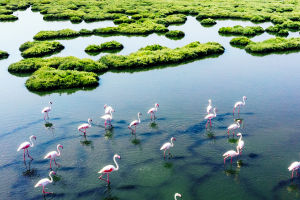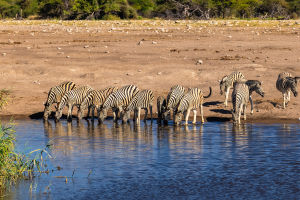Have you ever wondered how some animals manage to survive in the most inhospitable places on Earth? Imagine living in a place where temperatures soar past 100°F (38°C) during the day, and drop below freezing at night, or where there's almost no water for miles around.
Yet, despite these challenges, life not only exists but thrives. From the icy tundra of the Arctic to the blistering deserts, animals have evolved incredible strategies to adapt to these extreme environments.
Animals don't just “survive” extreme conditions—they've developed fascinating, and often mind-blowing, ways of thriving where most humans would struggle to stay alive. In this article, we'll explore how these creatures cope with everything from freezing cold to scorching heat, and what makes them so uniquely suited to their environments.
Adapting to Extreme Cold
The Arctic, Antarctica, and other frigid zones may seem completely uninhabitable to us, but animals there have evolved incredible adaptations to cope with freezing temperatures. From thick fur coats to antifreeze in their blood, these animals have developed ways to keep warm and conserve energy.
1. Thick Fur and Blubber: The snow leopard, another cold-adapted animal, uses its long, bushy tail for warmth, wrapping it around its body to shield itself from the cold.
2. Antifreeze Proteins: Some fish and insects that live in icy waters have proteins in their blood that work like antifreeze, preventing their bodies from freezing solid. The Antarctic icefish, for example, has antifreeze proteins that keep its blood flowing even in sub-zero temperatures.
3. Hibernation and Torpor: Many animals in cold climates enter a state of hibernation or torpor to survive the harsh winters. This means they drastically reduce their metabolic rate to conserve energy. For example, some frogs in northern regions hibernate by freezing their bodies, essentially "shutting down" until warmer weather arrives.
Thriving in Blazing Heat
On the other end of the spectrum, animals that live in deserts or hot climates face entirely different challenges. With limited water and intense heat, these animals have evolved a variety of unique strategies to avoid overheating and conserve moisture.
1. Nocturnal Habits: Many desert animals, like the Fennec fox, are nocturnal, meaning they only come out at night when the temperatures drop. This helps them avoid the scorching heat of the day. Other animals, like certain rodents, stay in burrows during the day and only forage for food during the cooler night hours.
2. Water Conservation: Animals in dry climates, such as camels, have developed remarkable ways to conserve water. Camels can survive without drinking water for long periods because they can store water in their bodies and regulate their body temperature to reduce water loss. Some animals, like the kangaroo rat, never drink water at all, instead extracting moisture from the food they eat.
3. Specialized Body Features: Many desert-dwelling animals have physical traits that help them survive the heat. For example, the spiny-tailed lizard has specialized scales that reflect sunlight and protect it from excessive heat, while the addax antelope has broad hooves that help it travel over hot sand without burning its feet.
Surviving in High Altitudes
At high altitudes, oxygen is scarce, and the air is thinner, making it harder to breathe. Despite these conditions, animals that live in mountain ranges or at high elevations have developed adaptations that help them thrive in these extreme environments.
1. Increased Red Blood Cells: Animals like the Himalayan tahr, a type of wild goat, have more red blood cells per unit of blood than animals at sea level. This allows them to carry more oxygen through their bodies and survive in areas where the oxygen level is lower.
2. Larger Lungs: Birds that migrate at high altitudes, such as the bar-headed goose, have evolved larger lungs that allow them to process more oxygen from the thin mountain air. They can fly over the Himalayas, an area where the oxygen levels are so low that it would be deadly for most other animals.
3. Thermal Regulation: Many high-altitude animals, like the snow leopard and the Andean condor, have specialized body insulation to keep them warm in freezing temperatures. This is often in the form of thick coats of fur or layers of blubber that protect them from the cold while they hunt or forage for food.
Water-Limited Environments: Adaptations in Aquatic Life
While some animals live in places with very little water, others live in environments where water is plentiful, but they still face extreme challenges, such as saltwater. These animals have evolved mechanisms to survive in such habitats.
1. Salt Excretion: Marine animals like sea birds and sea turtles have specialized glands that help them excrete excess salt from their bodies. These glands allow them to drink seawater without becoming dehydrated. The salt is expelled from their bodies through their nostrils or by excreting it through their eyes.
2. Breathing Techniques: Marine mammals like dolphins and whales have the ability to hold their breath for extended periods, allowing them to dive deep into the ocean for food without having to resurface for air. They also have specialized blood that can store oxygen for longer periods, making deep dives easier.
3. Efficient Locomotion: Fish like the manta ray have specialized fins that help them move efficiently through water, reducing the amount of energy they need to spend. Their streamlined bodies make them well-suited for swift swimming through the ocean's depths.
Conclusion
Whether enduring extreme cold, scorching heat, or high altitudes, animals have an amazing ability to adapt and thrive in environments that would be impossible for most humans. These adaptations—ranging from physical changes to behavioral adjustments—help animals overcome extreme conditions and ensure their survival. By learning about these incredible survival mechanisms, we gain a deeper appreciation for the resilience of wildlife and the wonders of nature's adaptability.


